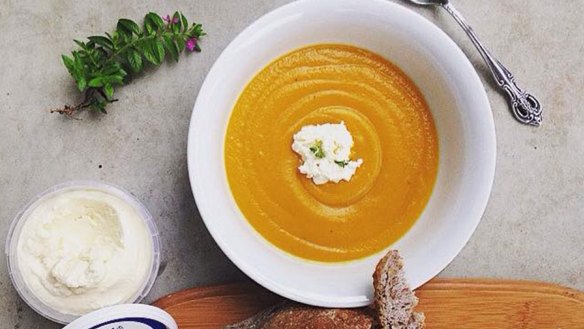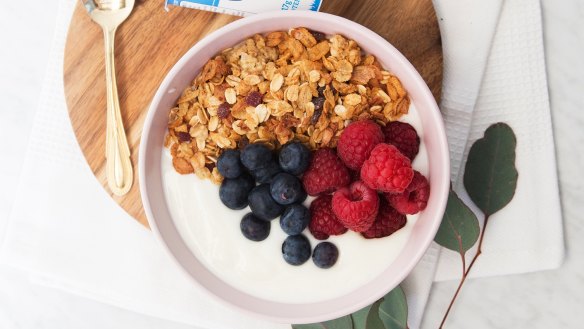Why quark is the next hot high-protein health food

At first lick, quark might seem hard to place. A little tangy, perhaps, and snowy and smooth. But it's not quite as rich as butter or cream. Or sour like yoghurt. Or lumpy like cottage cheese.
It's plainer than its dairy brethren. Mild and austere. Spoon a dollop straight from the tub and you might wonder what you're meant to do with it.

Like any blank canvas, it's made to be adorned. The Germans and Swiss eat it by the trolley-full – with jam, mixed with fruit or on bread. It's the chameleon of the Continental kitchen, to be dressed up or down as you please – in pastas, cakes and even curries.
And though it's taken a while, it seems Australians are finally switching on to quark, too. Dedicated devotees, who once hunted down hard-to-find tubs in specialty grocers, now only have to venture as far as their local supermarket to find quark squeezed between blocks of Coon and Kraft.
Melbourne brand Rokeby Farms recently launched Swedish-style "quark yoghurt" in Woolworths stores around the country, for example, while Aldi is trialling two options – a regular Swiss style, or low-fat German style – in NSW and selected Victorian stores.
You can use it as a replacement for sour cream on baked potatoes, you can use it for a dip or make a cheesecake out of it, you can use it instead of butter on toast.
But first, the basics. What is quark? Not to be confused with the subatomic particle of the same name, quark is a white soft, fresh dairy spread often compared to cream or cottage cheese. It's usually made by fermenting and warming milk with live cultures, then straining it. Unlike cheese, it generally contains little to no salt or rennet, and it's not traditionally based on whey like ricotta, though the exact process varies from manufacturer to manufacturer. Richer, fancier styles add fruit, spices or cream.
Quark is particularly appealing to health-conscious eaters, Melbourne sports dietitian Simone Austin says.
Nutritionally, quark tends to be higher in protein and calcium and much lower in fat than cream cheese, lower in salt than cottage cheese and lower in sugar than yoghurt.
"It's also not so sour tasting [like yoghurt]. I know when I'm working with older adults it's really important they have protein in their diet but they don't like yoghurt because it's sour," Austin says. "So that's a real bonus to get protein without that sour taste."
To maximise the creamy taste and texture, Rokeby Farms cold filters the raw milk before slowly fermenting the mixture with a combination of yoghurt and quark cheese cultures. The result has about 1 gram of fat, 10 grams of protein and almost 300 milligrams of calcium per 100 grams. In comparison, a Greek yoghurt may have up to 10 grams of fat, 4-5 grams of protein and 130 milligrams of calcium.
"You'd be hard pressed to find a yoghurt product in Australia that would be as thick," says Luke Marget, a co-founder of Made, the company behind Rokeby Farms. "In comparison to yoghurt it's very thick but it's still not as thick as cream cheese – so it's still spoonable and you can enjoy it from the pot."
How does the taste stack up? "What you end up getting is a fairly unique flavour profile – it has a little bit of bite like a yoghurt ... and you have the savoury, slightly cheesy note you get from those quark cheese cultures," Marget says.
Ian Campbell from Barambah Organics in Queensland agrees. His company has been selling quark in boutique grocers for the past decade and recently introduced a low-fat version to the market. The low pH also means no preservatives need to be added.
When people try it for the first time at food fairs and hear about its versatility and nutritional profile, they often buy two or three tubs at a time, Campbell says.
"You can use it for so many different things," he says. "You can use it as a replacement for sour cream on baked potatoes, you can use it for a dip or make a cheesecake out of it, you can use it instead of butter on toast.
"You can use it for every meal and that's what the Germans and a lot of Europeans do – they pull it out at any opportunity."
Once, while training for a triathlon and looking for an extra energy boost, Campbell even mixed quark with instant coffee as a lark.
The verdict? "Even with something as rough as Nescafe 43 it was a great combination."
The best recipes from Australia's leading chefs straight to your inbox.
Sign upFrom our partners
Original URL: https://www.watoday.com.au/goodfood/tips-and-advice/why-quark-is-the-next-hot-highprotein-health-food-20170410-gvi07y.html
